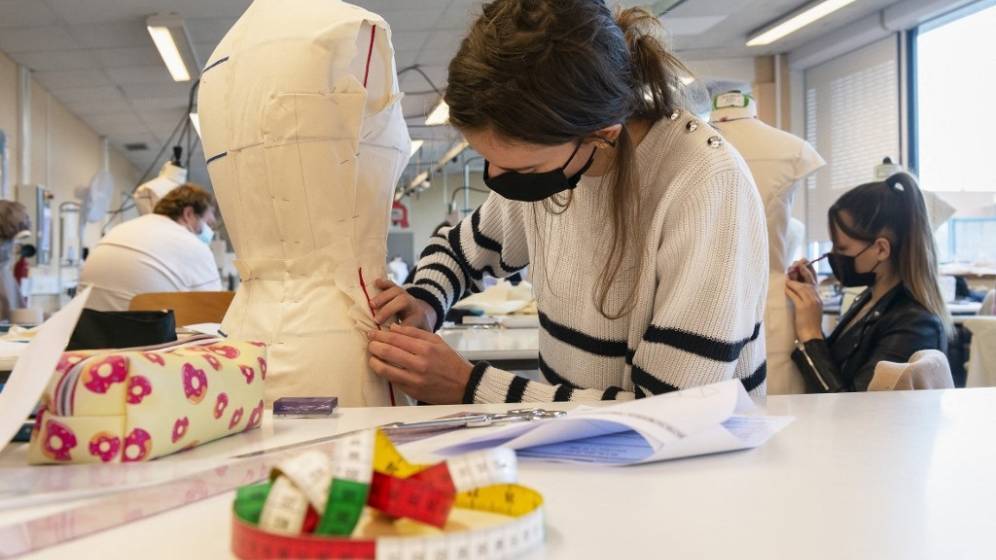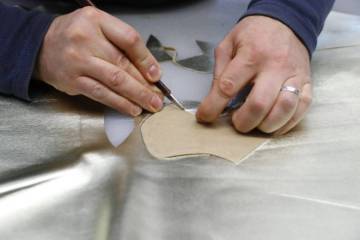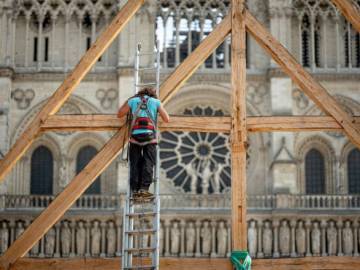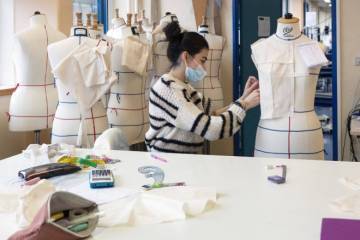Les métiers d’art et les métiers du patrimoine ont le vent en poupe. Il n’est qu’à voir le public se presser à la rencontre de leurs professionnels dans les allées du Salon international du patrimoine culturel, qui s’est tenu du 27 au 30 octobre au Carrousel du Louvre, à Paris, pour s’en persuader. Les 281 métiers d’art recensés – c’est un arrêté du 24 décembre 2015 qui en fixe le nombre officiel – émerveillent les amateurs autant qu’ils mobilisent les professionnels par l’excellence de leurs savoir-faire et la diversité de leurs registres.
Pour autant, si « l’attractivité » des métiers d’art et des métiers du patrimoine est particulièrement forte, notamment, et c’est très prometteur, auprès des plus jeunes, le secteur, qui a traversé la crise sanitaire et fait face aujourd’hui aux difficultés d’une conjoncture inflationniste, doit redéfinir ses enjeux et redessiner les contours de son avenir, notamment au plan économique. L’avenir des métiers d’art et des métiers du patrimoine, c’était précisément le thème de la rencontre organisée le 29 octobre pendant le Salon du patrimoine culturel par le ministère de la Culture : « métiers d’art, métiers du patrimoine : quels enjeux pour demain ? »
Réécoutez la table-ronde « métiers d’art, métiers du patrimoine : quels enjeux pour demain ? »
Un écosystème phare de l’excellence française
Depuis de nombreuses années, l’État – ministère de la Culture et ministère de l’Économie et des Finances – accompagne durablement les métiers d’art et des métiers du patrimoine, qui contribuent au rayonnement de l’excellence française. Soutien en termes d’emploi (le ministère de la Culture, qui peut s’appuyer sur le « riche tissu professionnel » de l’écosystème, est « le premier employeur public des métiers d’art » avec la Manufacture de Sèvres, le Mobilier national, ou les châteaux-musées, souligne Florent Kieffer, chef du bureau des industries créatives à la direction générale de la création artistique du ministère de la Culture). Soutien également en termes de financement et de formation (« le ministère de la Culture subventionne des sites de production, contribue au financement de l’Institut national des métiers d’art et instruit le label Entreprise du patrimoine vivant, dont 1300 entreprises bénéficient aujourd’hui », poursuit-il).
En dépit de ce soutien de l’État, l’écosystème reste fragile, et les professionnels évoquent leur combat « pour ne pas disparaître ». C’est le cas de Serge Pascal, Maître d'Art « Releveur-Repousseur » (un métier qui consiste à « ornementer un travail de serrurerie sur des grilles des XVIIe, XVIIIe et XIXe siècles »), qui souligne que les 140 Maîtres d’Art sont « les représentants de professions remarquables à risque de disparition ». C’est le cas aussi de Richard Boyer, directeur général chez SOCRA, adhérent au Groupement des entreprises de restauration des monuments historiques, qui revendique « 210 entreprises, 10 000 salariés, 1000 apprentis ». La vocation de son Groupement ? « Promouvoir les savoir-faire pour éviter que les métiers disparaissent ». C’est le cas, enfin, de Clémentine Bollard, présidente de la Fédération française des professionnels de la conservation-restauration, qui comprend 1700 diplômés, dont 1300 professionnels en activité. « 76% exercent en indépendant et 83% sont des femmes » précise-t-elle, en soulignant que la fédération leur « apporte un appui au quotidien dans l’exercice de leur activité ».
Un réseau d’entreprises spécialisées
Parmi les fragilités de l’écosystème, on note une forte dépendance au contexte économique. En cette période où l’inflation est repartie à la hausse, Isabelle Chave, sous-directrice des monuments historiques et des sites patrimoniaux à la direction générale des patrimoines et de l’architecture du ministère de la Culture, évoque les « difficultés d’approvisionnement » qui bloquent la tenue normale d’un chantier patrimonial. « Nos métiers sont assujettis à 80% aux appels d’offres publics, renchérit Richard Boyer. Nous nous tenons à un prix établi un an avant la réalisation des travaux ; or, s’il y a bien des systèmes de remise à niveau, ceux-ci ne sont pas suffisants ». Il s’inquiète notamment des marchés reportés pour des petites opérations dans des communes.
Certains préfèrent insister sur les soutiens apportés par l’État pour remédier à ces situations. C’est le cas de Clémentine Bollard, qui reconnaît un « impact limité » du contexte inflationniste sur l’activité des professionnels du champ de la conservation-restauration. « Les aides ont été nombreuses et nous fonctionnons par regroupements qui se forment de façon ad hoc », dit-elle. De plus, si pendant la crise sanitaire, certains professionnels sont « sortis du champ des aides » – une étude a en effet montré que le secteur conservation-restauration était éclaté sous 34 codes d’activités différents – « une catégorie « métiers d’art » appuyée par le ministère de la Culture existe aujourd’hui dans la nomenclature de l’INSEE ». Celle-ci devrait permettre une meilleure prise en compte des situations de chaque entreprise.
Transmission, formation, valorisation
L’une des spécificités de l’écosystème est son rapport profondément original à la formation et à la transmission, qui passe par un rapport au temps très particulier. « Il faut souvent toute une vie pour se former à ces métiers », assure Isabelle Chave.
Le titre de Maître d’art, décerné à vie par le ministère de la Culture à des professionnels qui possèdent un savoir-faire rare et souhaitent transmettre leurs connaissances à élève, en est la preuve. « Les Maîtres d’art, cette spécificité française, ont généralement plusieurs décennies de pratique, ce qui les départage, c’est leur capacité à transmettre », souligne Florent Kieffer, qui se félicite que la parité femmes-hommes soit aujourd’hui parfaite parmi les Maîtres d’art. « Le savoir-faire fait partie du patrimoine, renchérit Serge Pascal. L’objectif est de préserver l’œuvre pour qu’elle puisse persister dans le temps, la formation est sur le long terme, pas pour des chantiers occasionnels, l’apprenti doit devenir un artisan complet ».
Le volet formation est bien sûr déterminant dans l’acquisition des savoir-faire spécifiques aux métiers d’art ainsi qu’aux métiers du patrimoine. On recense ainsi plus de 1000 lieux de formation dédiés aux métiers d’art en France. Richard Boyer insiste sur ces campus qui voient le jour. Leur proposition ? « Regrouper des centres de formation pour proposer aux jeunes de se former aux métiers du patrimoine », relève-t-il. Autre élément : la validation des acquis de l’expérience (VAE). Tous les diplômes proposés en formation initiale peuvent en bénéficier : « les attributaires suivent alors quelques modules complémentaires, relevant aussi bien de la théorie que de la pratique, pour finaliser leur VAE », détaille Clémentine Bollard.
Dernier point : la « valorisation » des métiers d’art et du patrimoine. Si elles existent déjà (qu’on songe à l’opération « À la découverte des métiers d’art » au collège ou au dispositif « Une école, un chantier, des métiers » ouvert aux scolaires à la découverte des monuments historiques), ces initiatives doivent être renforcées de façon significative, plaide Florent Kieffer, qui appelle à la multiplication des « opérations de sensibilisation ». « Il faut une montée en compétences et des accompagnements adaptés aux jeunes », conclut-il.
Métiers d’art : vers un plan interministériel pour structurer l’écosystème
Sur l’ensemble de ces questions, un large travail va être lancé sous l’égide des ministères de la Culture, de l’Économie et des finances et de l’Éducation nationale qui devrait déboucher « prochainement sur un grand plan sur les métiers d’art », a indiqué Florent Kieffer, chef du bureau des industries créatives à la direction générale de la création artistique du ministère de la Culture.
Partager la page




